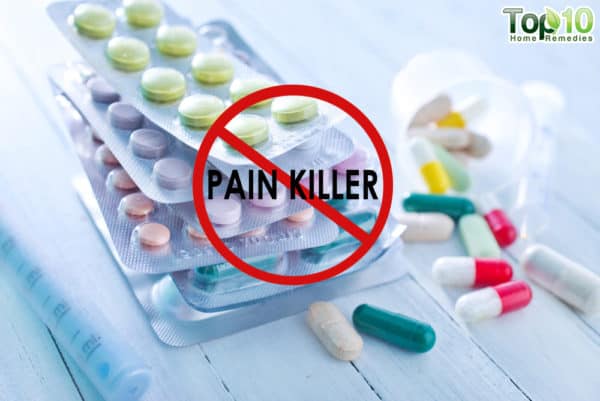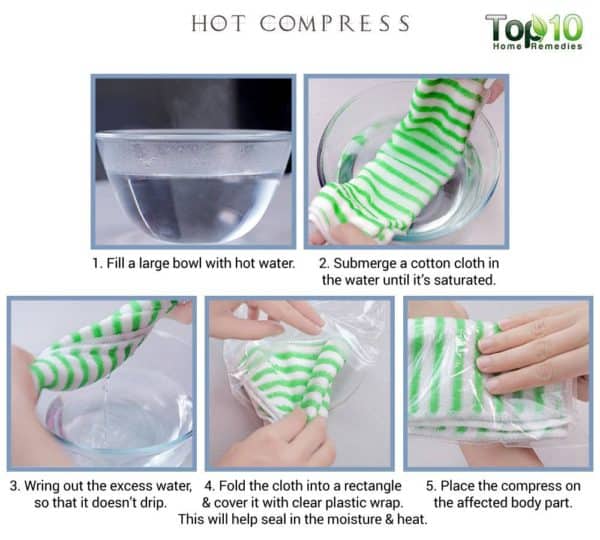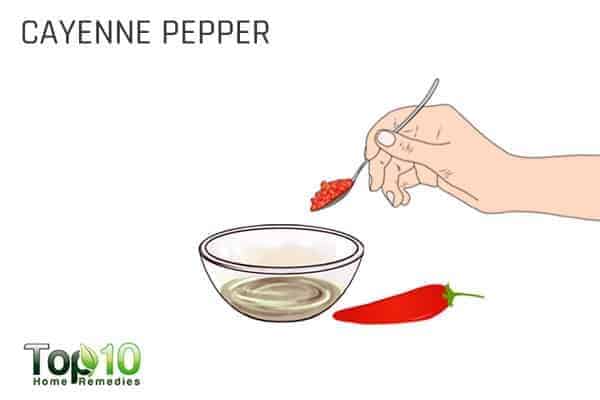Analgésiques incroyable que vous avez dans votre maison
Aspirin, ibuprofen and naproxen — known as non-steroidal
anti-inflammatory drugs (NSAIDs) — are some of the common painkillers
that you might have in your medicine cabinet.
As soon as you start
having a headache, toothache, stomachache, backache or any other type
of pain, without thinking about anything else, you simply reach for one
of those painkillers.
It is true that medicines that relieve pain
are valuable tools for doctors as well as patients. But like all drugs,
NSAIDs come with plenty of short-term side effects, such as rashes, heartburn, nausea and stomach upset.
Worse yet, prolonged use of the pain-killing medications can cause various harmful side effects, including liver damage, kidney problems, stomach ulcers and increased risk of a stroke and heart attack.
In
the recent past, there have been many incidents that warn us against
the regular use of such painkillers. In fact, health experts recommend
using natural painkillers to beat the pain without the potential side
effects.
For natural painkillers, you do not have to go to the market. There are many painkillers that you already have in your home.
Here are some of the natural painkillers that you have in your home.
1. Ice Pack
An
ice pack is one of the most effective pain relief treatments available.
In fact, whether you are suffering from jaw pain, back pain or pain due
to a sudden fall or injury, an ice pack is very beneficial. Even for postpartum pain, an ice pack is effective.
A
study published in Women and Birth in 2016 found that applying an ice
pack for 20 minutes is effective for alleviating postpartum perineal
pain and continues to be effective between 1 hour 35 minutes and 2 hours
(1).
An
ice pack helps reduce inflammation and pain during the first 48 hours.
The cold temperature restricts circulation and offers a numbing effect
on the nerves, which plays a key role in reducing swelling and
inflammation.
There are many types of ice packs that can be used
for pain relief. You can find reusable cold packs or ice packs in the
market, but you can always make one with ice cubes that you have in your freezer.
- Put some ice cubes in a plastic bag and wrap it in a towel.
- Apply it on the painful area for no more than 20 minutes at a time.
- Repeat several times a day, as needed.
2. Hot Compress
Another very common home remedy for pain relief is applying heat directly on the painful areas.
A
hot compress is effective for any kind of acute or chronic pain. The
heat helps dilate blood vessels, which makes it easier for the blood to
distribute nutrients throughout the body as well as flush out toxins.
This in turn helps relieve pain.
A
2014 study published in the Journal of Clinical & Diagnostic
Research indicates that the application of thermotherapy and
cryotherapy, accompanied by a pharmacologic treatment, could relieve
pain in patients with acute low back pain (2).
For heat therapy, you can buy hot packs from the market. But you can also make one at home.
- Soak a cotton cloth in hot water and wring out the excess water.
- Place the warm cloth on the affected body part for 15 to 20 minutes at a time.
- Repeat every 2 hours, as needed.
3. Turmeric
The bright yellow spice that you might have in your kitchen for cooking also works as a natural painkiller.
Turmeric
is rich in a compound called curcumin, an antioxidant that helps
protect the body from free radicals. This in turn soothes pain. In fact,
turmeric is extremely good for body aches, joint pains and internal body injuries that result in inflammation.
A
2003 study published in the Journal of Alternative and Complementary
Medicine reports that curcumin exerts anti-inflammatory activity by
inhibition of a number of different molecules that play a role in
inflammation (3).
A
2007 study published in Advances in Experimental Medicine and Biology
describes both antioxidant and anti-inflammatory properties of curcumin
and its therapeutic use against different pathological conditions, such
as cancer, atherosclerosis, neurodegenerative diseases and inflammatory
disorders (4).
A
study published in the Alternative Medicine Review in 2009 indicates
curcumin may have potential as a therapeutic agent in diseases like
inflammatory bowel disease, pancreatitis, arthritis, chronic anterior
uveitis and certain types of cancer (5).
- The best way to use turmeric is to mix 1 teaspoon of turmeric powder in a cup of hot milk and drink it 2 or 3 times a day.
4. Cloves
Whole and ground cloves are often used for culinary purposes. As a medicine, cloves work as a powerful painkiller.
Cloves may help relieve the pain associated with toothaches, headaches and arthritic inflammation. Both the whole clove and the oil form can be used as part of a topical pain reliever.
A
2014 study published in the Asian Pacific Journal of Tropical
Biomedicine reports that the use of clove as an analgesic has been
reported since the 13th century for toothaches, joint pain and as an
antispasmodic, with eugenol being the main compound responsible for this
activity (6).
- For a toothache, chew a whole clove or dab a little clove oil on the sore tooth and the surrounding gums using a cotton ball to relieve the pain.
- For muscle or joint pain, mix a few drops of clove oil with any carrier oil. Use it to massage the painful area for a couple of minutes.
You can follow either of these remedies a few times a day, as needed.
5. Cayenne Pepper
If
you’re a lover of spicy food and have a bottle of cayenne pepper in
your spice rack, then you have a natural painkiller right in your
kitchen.
The compound capsaicin in cayenne pepper exhibits an
anti-inflammatory effect that helps reduce pain and inflammation. It
also prevents the activation of the brain’s pain transmitters, which in
turn reduces the feeling of pain.
This is why many over-the-counter pain-reducing creams or ointments contain some amount of purified capsaicin.
A
2011 study published in the British Journal of Anesthesia notes that
topical application of capsaicin cream is effective for pain management (7).
Another
study published in 2016 in Molecules highlights the analgesic effects
of capsaicin and its clinical applicability in treating pain (8).
Using cayenne pepper, you can make a homemade pain-relieving ointment.
- Mix ½ teaspoon of ground cayenne pepper and 2 to 3 teaspoons of warm olive or coconut oil.
- Apply it on the painful area.
- Let it sit for 10 to 15 minutes, then rinse it off.
- Repeat once daily until the pain is gone.
6. Ginger
If
you love to drink ginger tea or use ginger in your cooking, you might
be happy to know that you are using a pain-relieving herb.
Ginger has strong anti-inflammatory properties in the form of the compound gingerol. This compound can help treat the pain associated with gout, rheumatoid arthritis and osteoarthritis.
According
to a 2005 study published in the Journal of Medicinal Food, ginger
affects certain inflammatory processes at a cellular level. This makes
it an effective treatment for both acute and chronic inflammatory
diseases (9).
Another
study published in 2010 in the Journal of Pain reports that daily
ginger consumption also reduces muscle pain caused by exercise (10).
- For consumption, add 1 to 2 teaspoons of ground ginger to your meals daily.
- For topical application, apply a warm ginger paste mixed with a little turmeric on the affected area twice a day.
- Also, steep 1 tablespoon of ginger slices in 1 cup of hot water for 5 minutes, then drink it 2 or 3 times a day to help relieve the pain.
7. Olive Oil
The popular oil that you use for cooking or salad dressing is also beneficial for reducing pain and inflammation.
A
2005 study published in Nature reports that olive oil contains a
non-steroidal anti-inflammatory agent that inhibits activity of
cyclooxygenase (COX) enzymes, which cause inflammation in the body (11).
Another
study published in Current Pharmaceutical Design in 2013 showed that
the compound called oleocanthal in extra-virgin olive oil prevents the
production of COX-1 and COX-2 enzymes in the body that cause
inflammation (12).
A
2013 study published in the Indian Journal of Physiotherapy and
Occupational Therapy reports that topical application of extra-virgin
olive oil proved to be effective in alleviating the symptoms of patients
diagnosed with knee osteoarthritis compared to topical application of
an NSAID (13).
When it comes to fighting inflammation, always opt for extra-virgin olive oil.
- For topical use, massage the painful area with warm olive oil to reduce pain, swelling and inflammation from arthritis and muscle cramps.
- For consumption, eat 1 to 2 tablespoons of extra-virgin olive oil on a daily basis to fight inflammation.









Comments
Post a Comment